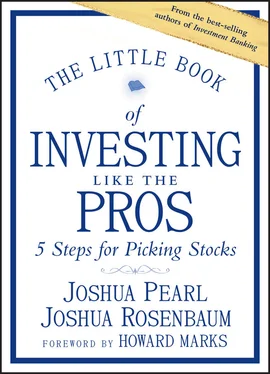Our book is structured as five chapters that correspond to the five steps in our framework. We use real-world examples throughout to bring these concepts to life.
1 Idea Generation
2 Identifying the Best Ideas
3 Business & Financial Due Diligence
4 Valuation & Catalysts
5 Investment Decision & Portfolio Management
Our flagship case study centers on Delphi Automotive, a global automotive supplier that was the predecessor company to what are now two distinct entities following a tax-free spin in December 2017. 2Today, these entities trade independently as Aptiv (APTV) and Delphi Technologies (DLPH).
Throughout the book, we focus on the opportunity that investors faced upon Delphi Automotive's initial public offering (IPO) in November 2011. By the time of the company's split in 2017, those who invested from the beginning made nearly five times their money. Using our framework, we take you back in time to illustratively guide you through the process that helped discover, analyze, value, and bless this stock.
Delphi was a textbook restructuring and turnaround opportunity. Before filing for bankruptcy in 2005, it had a fragmented business model with an uncompetitive cost structure and burdensome liabilities. Delphi used the bankruptcy process to rationalize its product lines, sell uncompetitive businesses, and migrate manufacturing to best-cost countries (BCCs). Delphi's lead shareholders, Silver Point Capital and Elliott Management, played a key role in the turnaround, working with CEO Rod O'Neal and the management team to transform the company. The reconfigured strategy for the “New Delphi” centered on technology and the three core themes of “Safe, Green and Connected.”
Upon emergence, Delphi featured a focused product portfolio, globally cost-competitive structure, and revamped balance sheet. The company also had a concentrated shareholder base that was very active in pursuing value creation. Over time, these core shareholders would be natural sellers as Delphi's stock performed.
As part of their value creation plan, the lead shareholders assembled a world-class Board of Directors, comprised of public company CEOs, auto industry veterans, and highly experienced domain experts (e.g., technology, human resources, capital markets, and M&A). Former DuPont Chairman and CEO Jack Krol was appointed Chairman of the Board and played a critical role. His background as lead director of Tyco International, where he oversaw their successful corporate overhaul, was a key factor in the lead shareholders' decision to bring him on board. He and his fellow directors were instrumental in working with management to develop the strategy around capital allocation, IPO preparation, and messaging to investors.
Delphi also emerged with a more competitive tax regime at the time due to its status as a U.K. tax payer. Add in secular and cyclical tailwinds, a fortified moat, improved financials, and a compelling valuation—in sum, there were multiple ways for an investor to win. There were also many risks to consider. You just had to know what to look for … and how to do the work.
In late 2011, Delphi went public at a $22 share price. The new strategy would prove enduring over the next several years, persisting long after O'Neal passed the reins to CFO Kevin Clark in 2015. Along the way, there were numerous strategic initiatives that created significant value for shareholders, culminating with the tax-free spin of Delphi's Powertrain Systems segment in 2017.
By the end of 2017, just prior to Delphi's separation into two entities, the stock was trading above $100 per share. Investors who seized upon the opportunity at Delphi's IPO were rewarded with a 375% return. This represented a 30% annualized return vs. the S&P 500 at 13%.
Our 5-step approach to stock picking is designed to help you uncover the next Delphi Automotive. It is also designed to help you manage your stock positions along the way. For example, in 2018, the automotive market began to show signs of a cyclical slowdown. As discussed in the Post-Mortem, the newly spun powertrain business, Delphi Technologies, also experienced some self-inflicted wounds and headwinds related to its geographic footprint. Our system of early warning signals and active monitoring is crafted to help you avoid these pitfalls. Knowing when to exit or downsize a position is no less important than determining when to enter or upsize.
Step I focuses on how professional investors source investment ideas. This process requires a great deal of patience and discipline. It is not uncommon to review dozens, or even hundreds, of companies before a high-quality opportunity is discovered.
Our book focuses on bottom-up investing, which is a company-first approach to identifying attractive stocks. You start with the individual company and perform in-depth analysis on its business drivers, financial performance, valuation, and future prospects. We also discuss the top-down approach, where you search for opportunities based on macroeconomic (“macro”) or secular themes. Key top-down strategies center on identifying global or domestic market and business trends/cycles, and buying the beneficiaries. The flip side is to avoid or even short the victims.
Experienced investors tend to incorporate elements of both bottom-up and top-down in their approach. For the bottom-up investor, paying insufficient attention to important macro and other big-picture trends is dangerous. Similarly, the successful top-down investor can't ignore fundamental analysis for individual companies.
In Step I, we discuss the primary buckets from which professional investors source their ideas. We start with undervalued companies for whom there is a path to improved financial performance or a higher valuation. We then focus on companies undertaking value-enhancing corporate actions, such as mergers & acquisitions (M&A), spin-offs & divestitures, restructurings & turnarounds, stock buybacks & dividends, IPOs, and insider buying. Lastly, we explain how to track proven investors to help source new ideas.
Step II: Identifying the Best Ideas
The initial idea search often yields dozens of potential investment opportunities. Step II explains how to parse through a broad list to identify the best ones. This involves a deeper examination of each stock in order to focus your attention on ideas that can become “core” positions. All you need are a few high-quality stocks to kick-start a strong portfolio.
This thinning of the herd relies upon performing high level research on each potential idea in a quick and systematic manner. Towards that end, we provide you with a framework that helps you do just that. It centers on investment thesis, business model, management team, risks & considerations, and financials & valuation . This preliminary analysis is necessary to separate fool's gold from the “real McCoy.”
We also provide a corresponding investment write-up template to help you track and organize your research on each stock idea. This template maps to our Step II framework and allows for easy comparison across multiple companies.
The longer the list of potential ideas generated from Step I, the more difficult the task of refining. Sometimes, an idea may jump off the page as a game-changer for your portfolio. In most cases, however, the ideas with the highest upside opportunity are not so black and white. Once the obvious outliers are eliminated, in-depth analysis on the remaining stocks can begin.
Step III: Business & Financial Due Diligence
In Step III, it's time to perform a much deeper dive on those opportunities that survived the culling process. More thorough business and financial research is needed following the early stage vetting. In other words, this is the key due diligence phase .
Читать дальше












